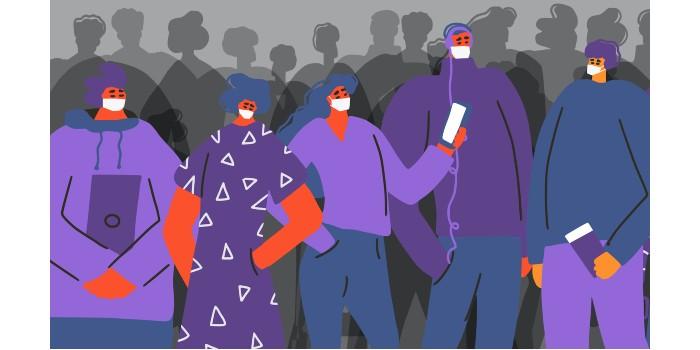 International. COVID-19 is one of the most disruptive events human society has experienced in the last 75 years. Beyond the struggles of 2020, this stark reminder of the biological threats we face will continue to reshape the way we live in the years to come.
International. COVID-19 is one of the most disruptive events human society has experienced in the last 75 years. Beyond the struggles of 2020, this stark reminder of the biological threats we face will continue to reshape the way we live in the years to come.
At the center of this debate are commercial real estate (CRE), the indoor environments where people from different households gather, where drops from 50% to 100% in occupancy levels have been common for months. CRE must now adapt to a post-COVID world that will create new winners and losers to reshape the construction industry forever.
As closures and stay-at-home orders began to set in around the world, the first challenge the buildings faced was being empty. Designed to be full, these facilities quickly realized that they can't simply turn off energy-consuming building systems. HVAC systems must circulate to prevent corrosion, security systems must monitor to protect assets, while emergency lighting is a legal requirement, even if another law now prevents public use of that building. The result is that an average commercial building is using more than 80% of the energy it would use in full occupancy, which unnecessarily contributes to operating costs and climate change.
"As the fear of the second waves of the virus becomes an understanding that the first wave is still strong, we need to start accepting that we are moving into a COVID [low-occupancy] era that can last quite a while," we wrote in a recent article. "Instead of using all its energy to fight this reality with hygiene and social distancing policies or technologies within buildings, the industry should save some effort to create a standby mode for buildings. That one button that can reduce energy consumption to a minimum, whether it's for 50% occupancy or zero."
Return to the buildings
We will return to our buildings but only being able to adapt them to the new post-COVID public health and safety environment. The traditional CRE cleaning market is a big winner with a much greater emphasis on the hygiene required to ensure compliance and occupant comfort. Much more comprehensive cleaning contracts will be signed and internal teams expanded, boosting a market that had been virtually stagnant for decades. Money flowing into cleaning will drive efficiency and innovation, such as ultraviolet light disinfection and the evolution of cobot-robot, which were promising niche technologies at best, before the pandemic.
The voice control market was steadily growing in the residential and automotive sectors before COVID, but is now expected to find its place in CRE as building operators strive for clean, contactless environments. Conversely, the market for CRE-centric touchscreen technologies could plummet. From long-standing building elements that had withstood the smart technology revolution, to the strongest trends that no one could have imagined losing, COVID-19 has disrupted indiscriminately.
Before COVID-19, modern office designs were increasingly open, with desks grouped together for greater cooperation and welcoming meeting spaces where employees could gather to share ideas. The brightest minds of office design focused on stimulating more "water cooling moments" where workers at all facilities could interact in this friendly, ad-hoc way that has proven to drive collaboration. None of this works in a post-COVID world that makes social distancing a higher priority.
Occupancy analysis for space utilization sought to maximize the number of people in a space, ensuring the health, well-being and productivity of the occupants. These technologies will now encounter exactly the same mission but reconfigured for a post-COVID world. "Occupancy analysis for social distancing" will be the holy grail for CRE to try to "maximize the number of people in a space" in this new health landscape, offering the visibility to deliver while generating profits. Forcing buildings without the technology to play it safe with densities much lower than those required to avoid the high cost of failures.
This disruption makes dumb buildings the real losers in a post-COVID world, lacking the sensory intelligence to keep occupants safe and fight for growth in a shrinking market. The economic downturn will bring consolidation in CRE and those buildings with the ability to track movement and monitor occupant behavior to optimize social distancing will take the lion's share of the diminished market. This is where the disruption of COVID-19 meets the long-running privacy debate, testing the resolve of businesses, governments, and societies to stand up for the rights of workers and the general public.
China's relatively quick and painless recovery from its COVID-19 outbreak can be credited in part by the unparalleled scale and sophistication of its surveillance technology, as well as its ability to exert tight control over citizen movement. Governments in Europe and North America tried to replicate that success with "track and trace" smartphone apps, but with limited success. As the pandemic continues with no end in sight, the economic fallout will force us to reconsider our stance toward privacy or innovate to avoid it.
In late July, California-based Density closed a $51 million funding round that will help address "unprecedented demand" for its infrared people-counting sensors, which have no way of determining occupants' gender or ethnicity, or performing invasive facials. thermal recognition or monitoring. Growing demand makes technology an example of privacy in a world that is being pressured to give up much for the sake of public health and the struggling economy.
"Imagine if you had perfect visibility of where all the large clusters of human beings were located across the country, outside of residential buildings and without invading privacy, for just a second. Just snap your fingers, you have access to that data, what would you do differently? Density CEO Andrew Farah asked in an interview with Memoori in April.
"I guess you'd have all sorts of new things you could do. If there are too many people, you can close it, but where there is a lot of space you can move people in that direction. I think we now have the opportunity to look at the physical space and try to understand what is missing."
Source: memoori research.


























Leave your comment